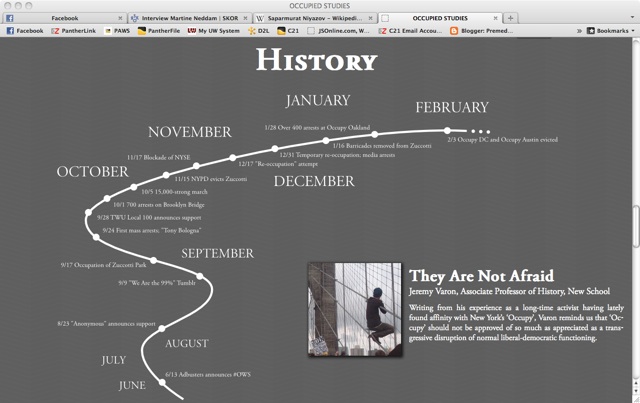By Annie McClanahan
The cover to the “History” section on Occupied Studies recently offered the timeline below as a guide to the movement’s history (thanks to Richard Grusin for pointing me to it and for the screen shot).
There is much to observe about this image, beginning from the very notion of history-as-timeline, which reminds me of Walter Benjamin’s critical description of a non-materialist historicism in which events merely “run through the fingers like the beads of a rosary.” Without the structuring logics of narrative, causation, or contradiction, this lapidary form cannot help but draw our attention to what is missing from it. Intense attention is paid to the Zuccotti Park crew, and rowdy, inspiring Oakland gets its hat-tip (though not until it is unsuccessfully evicted), but we see nothing of occupations in Atlanta and Boston and Cleveland and Detroit and Eureka (not to mention London and Rome and Costa Rica…) nor of dozens and dozens of other “occupies” both geographic and virtual.
What is perhaps more striking than these missing occupied cities is the timeline’s account of origin: “Adbusters announces #OWS.” This origin presents the uncanny circularity of the performative utterance: what did “#OWS” mean before there was a movement? What does it mean to suggest that a movement identified not by its strategy, its demands, or its political constitution but primarily by its characteristic tactic, emerged sui generis out of a media campaign? Given that occupation is a distinctly material tactic—concerned with space, with bodies, and with the obstruction of the business-as-usual that would normally take place in that space—what does it mean to suggest that the birth of this movement occurred not in the gathering of people in an occupied space but in a Twitter hashtag?
In any case, we can certainly see that this account of OWS’s “history” is a provincializing one. In the same way that the events of OWS history appear largely restricted to New York City (or, if we include Oakland, to a familiarly coastal political imaginary), the pre-history of OWS is also overly localized. After all, the most frequently-invoked precursor of or inspiration for OWS was the plaza occupations of the “Arab Spring.” We might also locate a more internationalist origin of the movement in the 2008 Greek riots protesting the fatal shooting of a teenager by Greek police; in anti-privatization and anti-austerity actions across Europe beginning in 2008; in university occupations in New York City, Santiago, Bogota, London, and elsewhere between 2009 and 2011.
OWS has origins closer to home, too, and it is it to these origins—to these pre-histories of OWS’s present—that our C21 symposium “Pre-Occupy” will turn. The first site in this genealogy is California: the January 1st, 2009 murder of an unarmed black man, Oscar Grant, by Oakland transit cops sparked activism and riots, and forged a powerful alliance among very disparate political groups in the Bay Area. (These solidarities would later support and make possible the occupation of Oakland’s Frank Ogawa Plaza, renamed “Oscar Grant Plaza,” in 2011.) In 2009, the tactic of occupation became central to a burgeoning student-worker-faculty movement to protest lay-offs, cuts, and fee increases in the University of California and California State University systems. An anonymous pamphlet titled “Communiqué from an Absent Future” which circulated widely in the lead-up to the struggles of 2009-2010, described occupation in terms that resonate powerfully with the strategy used by OWS some two years later: “Occupation,” the authors wrote, makes possible “a momentary opening in capitalist time and space, a rearrangement that sketche[s] the contours of a new society….[even though] these free zones will be partial and transitory, the tensions they expose between the real and the possible can push the struggle in a more radical direction.” Invoking the slogan “Occupy Everything, Demand Nothing,” the Communiqué refused, as OWS has likewise so far refused, to limit these possible openings by the articulation of demands.
OWS’s other pre-history was, as many readers of this blog already know, the mass political mobilization that occurred across Wisconsin in 2011 as a response to Governor Scott Walker’s budget cuts and anti-union legislation. I will leave a more thorough account of that movement to those who participated in it, and especially to Dan Wang’s presentation at C21 on 4/13. For the time being, let me simply observe that in Wisconsin, as in California, occupation (of the capitol building and other sites of state government, but also of the university, as in the months-long occupation of an arts building on the UWM campus in the spring of 2011) was a central tactic, one that enabled a powerful diversity of interests, positions, and political subjectivities. Neither Wisconsin nor California appear as part of OWS’s “history” in the image above.
For all that the “Occupied Studies’” version of OWS history leaves out, of course, it must be admitted that when applied to the shifting present, historical form—the articulation of what I described above as narrative, causation, or contradiction—often is more slippery or uncertain than our analytic models can acknowledge or account for. I have myself encountered the problem of how to construct this kind of history, one written in and for and beyond the moment and the movement, one that can account both for futures and origins, one that can explain under what conditions transformation can become possible. In 2009, when the UCB campus where I was a graduate student somewhat unexpectedly exploded into radical political action, I was thinking and writing a lot about history and about the future, about structure and event, and I often found myself arguing against the over-easy fetishization of the unpredictable and the uncertain as inherently revolutionary. A true historicism, I was arguing in my intellectual work, would be able to account for the relationship—however mediated, however overdetermined—between events and their causes.
And yet I also found myself confronted, in the chaotic and heady days of that fall and spring, with the profoundly unpredictable nature of collective action. In a cycle at once vicious and virtuous, for instance, spectacular police violence has often seemed to ignite rather than repress the radical movements of the past few years, but this is not a strategy that organizers can predict or an effect of which they can be certain. At other key points, it felt like the decision of a single union to call a strike, or the fact that a big UC Regents meeting was due to be held on a particularly well-organized campus, or the poetically ham-fisted statement made by UC President Mark Yudof in a New York Times Magazine interview (“Being president of the UC is like being the manager of a cemetery…”) were the unpredictable events on which success or failure depended. It sometimes even seemed that contingencies as pure and indeterminable as the weather itself shaped the odds of how the campus would respond: the pounding rain of November 20th, when hundreds pulled tarps over arm-in-arm barricades surrounding occupied Wheeler Hall, brought students and their allies together in a shared experience of physical discomfort and political exuberance. Are these things history? Were they origins, determinates, necessary conditions? Such absent, contingent causes often appear to refuse a strategic analytic, making it difficult to know what the lessons of success (and failure) might be.
It is hard, in other words, to know what came first and what comes next from the restricted, contingent perspective of what Benjamin describes as the explosive “here and now.” No matter how revolutionary, history appears to require a kind of retrospection both materially and epistemologically unavailable when one is standing at the barricades. And yet without such histories, we remain mired in the provincial presentism of the timeline and the news report, our origins magically appearing from blank emptiness and our future an elliptical fade-out.
[Annie McClanahan is a co-organizer of the Center for 21st Century Studies Pre-occupy Symposium. She is an Assistant Professor of English at UWM, currently at work on a book project titled, Fictitious Capital: Debt, Crisis, and Twenty-First Century Culture.]







